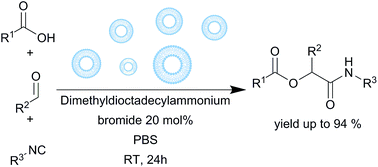Efficient Passerini reactions in an aqueous vesicle system†
Abstract
As an example of a one-pot multicomponent reaction, the formation of α-acyloxy carboxamides from a carboxylic acid, an aldehyde and an isocyanide (Passerini reaction) was investigated in aqueous solution in the presence of different types of surfactants. With dioctadecyldimethylammonium bromide (DODAB), a known vesicle-forming cationic surfactant, the reaction with hydrophobic starting materials proceeded with higher yields than without DODAB and with higher yields than in dichloromethane. These results demonstrate the potential of aqueous surfactant vesicle systems as promoters of multicomponent reactions.


 Please wait while we load your content...
Please wait while we load your content...